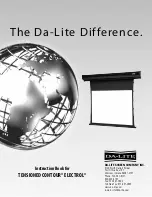
WWW.BALTIMOREAIRCOIL.COM
19
Corrosion Protection
Water Treatment
Corrosion and Scale Control
•
Scale Formation
– Scale, typically a calcium or magnesium based build-up, not
only reduces heat transfer and system efficiency, but also may lead to under deposit
corrosion. If scale is not controlled, it may continue building on critical components
such as the fill and severely impact thermal performance.
•
Biological Fouling
– Slime and algae formations may reduce heat transfer, promote
corrosion, and harbor pathogens such as Legionella.
Corrosion and Scale Control
• To control corrosion and scale, maintain the water chemistry of the recirculating water
within the parameters listed in
Table 2
below. The specific measures required vary
from system to system and are dependent on the chemistry of the make-up water, the
metallurgy of the piping and heat transfer devices exposed to the recirculating water,
and the temperatures at which the system will be operating.
• Bleed/blowdown, the continuous flow of a small portion of the recirculating water to
a drain, is used to control the concentration of dissolved solids. On rare occasions,
this may be adequate to control scale and corrosion. More often, chemical scale and
corrosion inhibitors are necessary, which raise the allowable level of dissolved solids
without the risk of scale and corrosion.
• Keep the chemically treated water within the guidelines given in
Table 2
. In cases
where bleed/blowdown alone is being employed for corrosion and scale control
without chemical treatment, your water treatment specialist may recommend more
conservative limits than those shown in
Table 2.
NOTES:
1.
Galvanized steel units require
passivation in order to
prevent white rust (refer to
“Passivation”).
2.
Hardness and alkalinity limits
may be exceeded under certain
circumstances. Consult your
water treatment specialist for
recommendations.
3.
The conversion factor used to
determine conductivity is 0.625
(TDS = 0.625 x Conductivity).
4.
EVERTOUGH™ Construction
units have a TriArmor
®
Corrosion
Protection System basin.
5.
The guidelines above refer to the
materials used in construction.
Different combinations of
materials may be used on the
same unit.
6.
Water chemistry will change
with operating temperatures.
The recommended guidelines
listed in
Table 2
refers to water
temperature at 95˚F.
Property of Water
Recommended Levels for Various Materials of Construction
Galvanized
Steel
Thermosetting
Hybrid Polymer
Type 304
Stainless Steel
TriArmor
®
Corrosion
Protection System or Type
316 Stainless Steel
pH
6.5 to 9.0
[1]
6.5 to 9.2
[1]
6.5 to 9.2
[1]
6.5 to 9.5
[1]
Total Suspended Solids
25 ppm
25 ppm
25 ppm
25 ppm
Total Dissolved Solids
(TDS)
1,500 ppm
2,050 ppm
2,050 ppm
2,500 ppm
Conductivity
2,400
(micromhos/cm)
3,300
(micromhos/cm)
3,300
(micromhos/cm)
4,000 (micromhos/cm)
Alkalinity as CaCO
3
500 ppm
[2]
600 ppm
[2]
600 ppm
[2]
600 ppm
[2]
Calcium Hardness as
CaCO
3
50 to 600 ppm
[2]
50 to 750 ppm
[2]
50 to 750 ppm
[2]
50 to 750 ppm
[2]
Chlorides (CL)
250 ppm
300 ppm
300 ppm
750 ppm
Sulfates
250 ppm
350 ppm
350 ppm
750 ppm
Silica
150 ppm
150 ppm
150 ppm
150 ppm
Table 2.
Quality Guidelines for Treated Circulated Water
















































